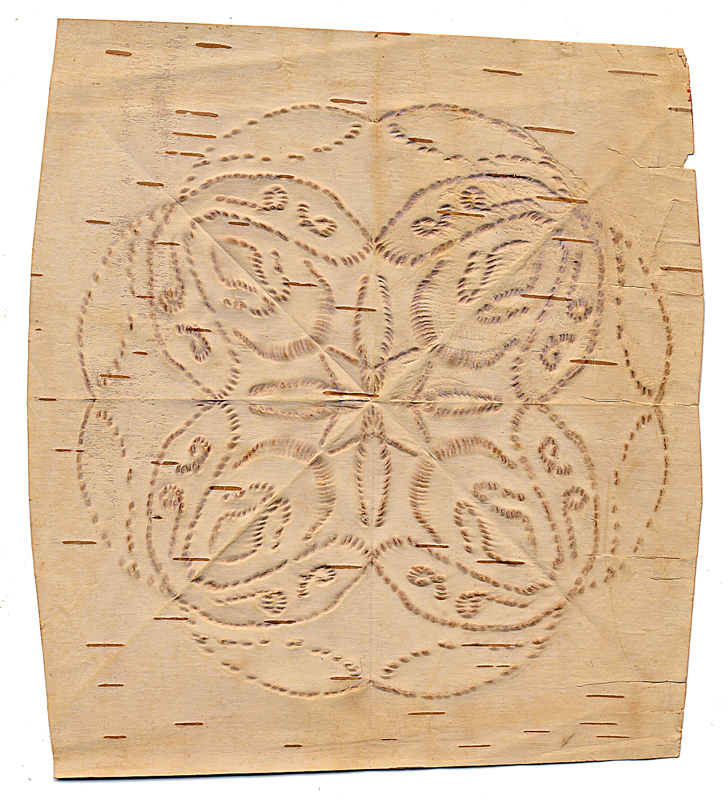
Birch bark biting artwork by Angelique Merasty.
Photo: Western Development Museum Collection,
WDM-1973-S-8214
similar to one I own by Ms. Merasty
Lovely meeting up with Emily to attend class virtuously virtually today. Thanks to my daughter for letting us crash her couch. Our conversations (and cat interruptions) along with today’s readings and presenters uncovered personal revelations and generated questions.
Relationships and Respect
What type of teacher would I have been if I hadn’t started my teaching career in Northern Saskatchewan? My last student teaching (I was in Music Education and at the time, they split up our practicum into parts so we could experience different situations) for Secondary Music was in a high indigenous population Prince Albert Elementary school. For my Secondary English minor, I was in Meadow Lake teaching middle and high school English, Math and Social Studies, again to a school with a high indigenous population. Being raised in southern Saskatchewan at the same time as Dr. Shauneen Pete, I was taught those stereotypes that she spoke of in class. And believed them. My practicum experiences showed me that kids are kids and each one wants to be listened to, met where they are, cared about, and be part of the conversation about how and where they need to go next.
Subbing in Band schools (yes, it still calls itself the Lac La Ronge Indian Band), teaching private music lessons and leading choirs at two of the public schools while my husband taught in a public school framed my practice after university. In all of my activities, creating community was at the forefront. If I didn’t foster community with the students at the band school, they wouldn’t attend school that day or they would leave. If I didn’t foster community with my private students, I wouldn’t have a self-employed work load at a sustainable income. It became a way of life to be part of that cultural way of being because you were living in an indigenous community. Hearing Shauneen speak reminding me of listening to Tom Roberts on CBC radio’s Keewatin Country in Northern Saskatchewan and chatting about it with everyone and anyone: Tân’si, edlánat’e and Hello. (And yes, I felt the blow when Tom Roberts’ legacy of radio from Northern Saskatchewan was shut down in 2012.)
Relationships, Respect, Reciprocity and Relevance
By building community, you wind up getting involved in giving back to that community. While in La Ronge, my volunteer work revolved around helping to establish a competitive but supportive music festival for students as well as a coop for local artists to sell their work (my job was the bookkeeping and establishing it as a non-profit organization.) Again, at the basis of the work was respect and relationships. Understanding the relevance of the work done whether as an artist, a musician, or a student was a given, particularly as you always were working on ‘northern time’ as we affectionally called it. Face-to-face meetings and time spent together working, even if you were doing different things, established a connectivity that is difficult to do through virtual environments. Or is it?
How many times did I spend extended time with the phone tucked between my ear and shoulder chatting with a friend? How does this tiegrad WhatsApp chat connect us in community even while we are in a BlueJeans class? Online, isn’t it important to connect students both with each other and the teacher as well as just with each other? By giving students a voice in class as well as the opportunity to connect privately with each other and with the teacher, could students be more successful? The success of Snapchat is partially because there is no easily visible trail of conversations as there are in WhatsApp. We are strangely motivated by knowing we are all struggling, though not in the same way. Can we get students to open up about that anonymously the way we contributed to the Padlet anonymously today? Lots of questions, lots to think about, lots of potential when I am looking at a research project.
More R’s
How does this relate to our courses’ focus on Researcher, Research, Researched and Reader? It took me a few days for my thoughts to connect (which is why this post is dated Tuesday but posted on Friday). As a researcher, we need to be aware of the history of the community in which we are doing research. Knowledge about the community can affect how you set up your research. Respect towards your Researched can improve the accuracy of your results. Relationships can taint your results, but they may also ensure your results are more authentic and therefore have more value. And if your Researched believe in the Relevance of your study and that Reciprocity is forthcoming, again, honesty in participation could be more prevalent. Research that is as trustworthy as possible is what is needed for genuine positive change to take place in education.
Responsibility
Settlers can learn a great deal from the Indigenous culture. We have a responsibility to our students to educate them about the history of our indigenous peoples, but also about how they have dealt with the difficulties with grace as a positive example to our students. Therefore, we also have the responsibility in our research endeavours to carry out our work in a manner that our indigenous peoples would find responsible and respectful.
PS – interesting blog I found on training to be more aware of indigenous relations, etc.
This blog was based on thoughts inspired from the reading of Chapter 3 by S. Pete in Idle No More edited by (2017), Chapter 10 by S. Pete in Meschachakanis, A Coyote Narrative: Decolonising Higher Education by Gruminder K. Bhambra, Dalia Gebrial and Kerem Nisancioglu, The Five R’s for Indigenizing Online Learning: A Case Study of the First Nations Schools’ Principals Course by Tessaro, Resoutle, Gaviria, Flessa, Lindeman, & Scully-Stewart (2018) and from the guest lecture/discussion with Shauneen Pete, UVic Indigenous Resurgence Coordinator.
Recent Comments